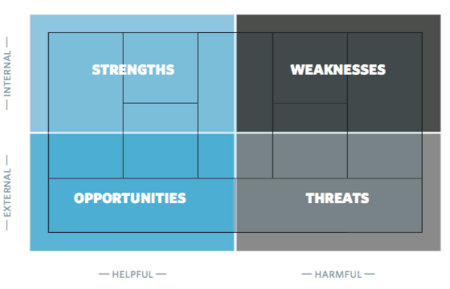SWOT Analysis Management
From DTU ProjectLab
(Difference between revisions)
| Line 6: | Line 6: | ||
A SWOT analysis is an analytical tool when it comes to value-based management and strategy formulation to define '''strengths''', '''weaknesses''', '''opportunities''' and '''threats''' for a given company. | A SWOT analysis is an analytical tool when it comes to value-based management and strategy formulation to define '''strengths''', '''weaknesses''', '''opportunities''' and '''threats''' for a given company. | ||
<ref>[''https://ivaekst.dk/vaekst/0/6/4/3/swotanalyse''] Strengths and weaknesses can be characterized as internal value-creating (or destructive) factors such as. assets, skills or resources that a company has at its disposal according to its competitors. The factors for the organization's strengths and weaknesses can be measured using internal assessments or by external benchmarking. Opportunities and threats are characterized as external value-creating (or destructive) conditions over which an organization has no direct influence, but instead emerge from the competitive dynamic connections of industry / market or from demographic, economic, technical, social or legal factors. Typically, you will be able to use the SWOT analysis in connection with any organization that intends to create a fit with its external environment. The SWOT table is an effective tool for analyzing the (internal) strengths and weaknesses of a company and the (external) opportunities and threats. However, this analysis will only be a single link of many when it comes to analysis at an organizational level. In fact, the creation of the adaptation will be a contradictory work to embark on, as the reality behind the SWOT analysis will most often point in contradictory directions, leaving strategists with the paradox of creating adaptation either from the outside (market-driven strategy) or from within. -out (resource-based strategy). | <ref>[''https://ivaekst.dk/vaekst/0/6/4/3/swotanalyse''] Strengths and weaknesses can be characterized as internal value-creating (or destructive) factors such as. assets, skills or resources that a company has at its disposal according to its competitors. The factors for the organization's strengths and weaknesses can be measured using internal assessments or by external benchmarking. Opportunities and threats are characterized as external value-creating (or destructive) conditions over which an organization has no direct influence, but instead emerge from the competitive dynamic connections of industry / market or from demographic, economic, technical, social or legal factors. Typically, you will be able to use the SWOT analysis in connection with any organization that intends to create a fit with its external environment. The SWOT table is an effective tool for analyzing the (internal) strengths and weaknesses of a company and the (external) opportunities and threats. However, this analysis will only be a single link of many when it comes to analysis at an organizational level. In fact, the creation of the adaptation will be a contradictory work to embark on, as the reality behind the SWOT analysis will most often point in contradictory directions, leaving strategists with the paradox of creating adaptation either from the outside (market-driven strategy) or from within. -out (resource-based strategy). | ||
| − | |||
== Introduction == | == Introduction == | ||
Revision as of 20:38, 11 February 2021
Developed by Helená Evin Cinar
Abstact
The article will shed light on the analysis tool SWOT model. The SWOT analysis is a frequently used method in strategy development in both private and public organizations. A SWOT analysis is an analytical tool when it comes to value-based management and strategy formulation to define strengths, weaknesses, opportunities and threats for a given company. [1]
Cite error:
<ref> tags exist, but no <references/> tag was found
